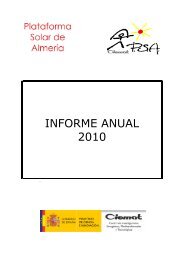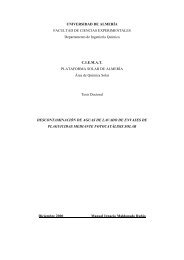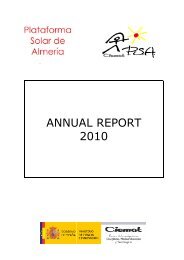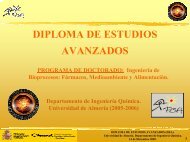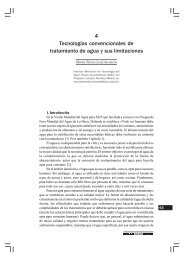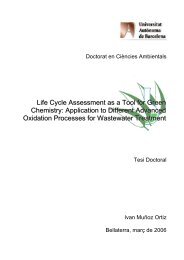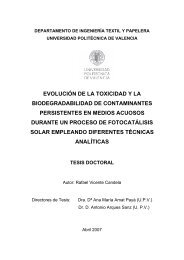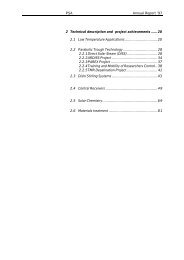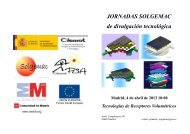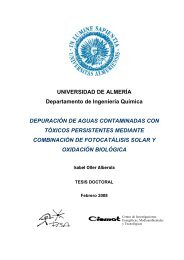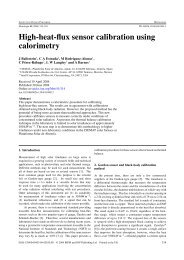Annual Report 2006 - Plataforma Solar de AlmerÃa
Annual Report 2006 - Plataforma Solar de AlmerÃa
Annual Report 2006 - Plataforma Solar de AlmerÃa
Create successful ePaper yourself
Turn your PDF publications into a flip-book with our unique Google optimized e-Paper software.
FACILITIES AND INSTALLATIONS<br />
nominal mean 90% reflectivity, the solar tracking error on each axis is<br />
1.2 mrad and the reflected beam image quality is 3 mrad. The CESA-1 facility<br />
has the most extensive experience in glass-metal heliostats in the world, with<br />
first generation units manufactured by SENER and CASA as well as second<br />
generation units with reflective facets by ASINEL and third generation facets<br />
and prototypes <strong>de</strong>veloped by CIEMAT and SOLUCAR. In spite of its over 20<br />
years of age, the heliostat field is in optimum working condition due to a strategic<br />
program of continual mirror-facet replacement and drive mechanism<br />
maintenance. To the north of the field are two additional areas used as test<br />
platforms for new heliostat prototypes, one located 380 m from the tower and<br />
the other 500 away from it. The maximum thermal power <strong>de</strong>livered by the<br />
field onto the receiver aperture is 7 MW. At a typical <strong>de</strong>sign irradiance of<br />
950 W/m 2 , a peak flux of 3.3 MW/m 2 is obtained. 99% of the power is focused<br />
on a 4-m-diameter circle and 90% in a 2.8-m circle.<br />
The 80-m-high concrete tower, which has a 100-ton load capacity, has<br />
three test levels:<br />
• A cavity adapted for use as a solar furnace for materials testing at<br />
45 m, which has been used very successfully in reproducing the heat<br />
ramp on space shuttles during their reentry into the atmosphere in<br />
test pieces of the ceramic shield and also for surface treatment of<br />
steels and other metal compounds.<br />
• A cavity with a calorimetry test bed for pressurized volumetric receivers<br />
at 60 m. At the present time this cavity houses the SOLGATE project<br />
infrastructure, which inclu<strong>de</strong>s three volumetric receivers with a total<br />
inci<strong>de</strong>nt power of nearly 1 MW, 250-kW solarized turbine, and corresponding<br />
electric generator, air loop, heat rejection system and<br />
thermal shield.<br />
• The 2.5-MW TSA volumetric receiver test facility at the top of the<br />
tower at 80 m.<br />
The tower is complete with a 5-ton-capacity crane at the top and a freight<br />
elevator that can handle up to 1000-kg loads. Finally, for those tests that<br />
require electricity production, the facility has a 1.2-MW two-stage turbine in a<br />
Rankine cycle <strong>de</strong>signed to operate with 520ºC 100-bar superheated steam<br />
2.2.2 The 2.7-MWth SSPS-CRS Facility<br />
The SSPS-CRS plant was inaugurated as part of the International Energy<br />
Agency’s SSPS project (Small <strong>Solar</strong> Power Systems) in September 1981.<br />
Originally an electricity production <strong>de</strong>monstration plant, it used a receiver<br />
cooled by liquid sodium that also acted as the thermal storage medium. At the<br />
present time, as with the CESA-I plant, it is a test facility <strong>de</strong>voted mainly to<br />
testing small solar receivers in the 200 to 350-kW th capacity range. The heliostat<br />
field is ma<strong>de</strong> up of 91 39.3-m 2 first generation Martin-Marietta units. A<br />
second field north of it has 20 52-m 2 and 65-m 2 second generation MBB and<br />
Asinel heliostats that can be used as support. The CRS heliostat field has recently<br />
been improved with the replacement of all the reflective facets, which<br />
now have a lightweight structure and low-iron glass. The most innovative feature<br />
are the completely autonomous intelligent heliostat-control units installed<br />
in 2003, powered by photovoltaic energy and communicating the entire field<br />
by radio by a concept <strong>de</strong>veloped and patented by PSA researchers. This first<br />
autonomous heliostat field, which does not require the use of channels or cabling,<br />
was ma<strong>de</strong> possible by financial assistance from the Ministry of Science<br />
and Technology’s PROFIT program.<br />
17



